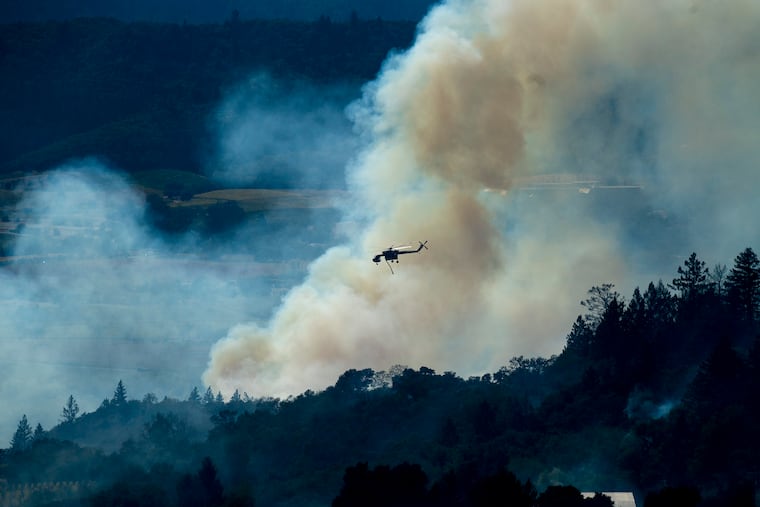Fast-moving wildfire ignites in Northern California wine country, prompting evacuations
As the wildfire torched Sonoma, and others began to spread elsewhere, Gov. Gavin Newsom railed against all three of California's investor-owned power companies, accusing them of neglecting their infrastructure and leaving the state vulnerable to fires sparked by outmoded power lines.

A fast-moving wildfire, aided by powerful winds, burned through Northern California on Thursday, forcing thousands of residents to evacuate parts of Sonoma County — the rural wine country 75 miles north of San Francisco that is still recovering from a deadly 2017 blaze.
The Kincade Fire, which started late Wednesday, spread rapidly overnight, burning more than 10,000 acres and growing at a rate of 30 football fields per minute. By Thursday afternoon, authorities were still struggling to fight it, and the fire remained zero percent contained, according to the California Department of Forestry and Fire Protection.
Pacific Gas & Electric, the state's largest utility, told state regulators on Thursday that a jumper on one of its transmission towers broke close to where officials say the fire started, near Geyserville.
Although PG&E cut power in the area on Wednesday afternoon amid dangerous weather conditions, stretches of the company’s high voltage power transmission lines — which were responsible for the state’s deadliest wildfire — were still operating in the area when the fire broke out, the utility said in a statement.
In the report it filed with the California Public Utilities Commission, PG&E said it became aware of the transmission tower malfunction at 9:20 Pacific Daylight Time on Wednesday. The fire began at 9:27 p.m., according to Cal Fire.
The Sonoma County Sheriff's Office ordered mandatory evacuations, including for the entire community of Geyserville, and shut down several major roads.
"This is not the time to stay," Sonoma Sheriff Mark Essick said at a news conference. "This is the time to go."
As the wildfire torched Sonoma, and others began to spread in San Bernadino, Los Angeles County and elsewhere, Gov. Gavin Newsom, a Democrat, railed against all three of the state's investor-owned power companies, including PG&E.
"I must confess, it is infuriating beyond words," Newsom said, accusing the utilities of neglecting their infrastructure and leaving the state vulnerable to fires sparked by outmoded power lines.
His statements echoed those he made two weeks earlier, when PG&E intentionally shut off power to nearly a million customers in a desperate hedge against wildfire risk.
"It's more than just climate change, and it is climate change, but it's more than that," Newsom said. "As it relates to PG&E, it's about dog-eat-dog capitalism meeting climate change, it's about corporate greed meeting climate change, it's about decades of mismanagement."
Newsom sent a letter Thursday to the the CEOs of San Diego Gas & Electric Company, Edison International and PG&E, demanding better communication about when the utilities would implement precautionary power shutoffs.
"The only consistency has been inconsistency," he wrote.
Weather forecasts in Northern and Southern California for the next several days have portended more blackouts and, perhaps, more fires. The National Weather Service said "pockets of critical fire weather" were likely.
The National Weather Service had already issued red flag warnings on Thursday for much of the San Francisco Bay Area, including the region where the Kincade Fire is burning, as blustering offshore winds met dry air and created tinderbox conditions.
Even though wind speeds were expected to lessen on Thursday, weather conditions through the weekend may bring new challenges to containing the fire. The offshore gusts, known as "El Diablo" winds, bring extremely dry air, with relative humidity plummeting to the single digits in some cases, making fire fighting particularly difficult. Forecasters expect a second round of those winds to blow across much of California in the coming days.
Meanwhile, in Southern California, "extremely critical" fire risk was forecast, with strong offshore winds, known there as Santa Ana winds, gusting up to 65 mph in parts of Ventura and Los Angeles counties through Friday.
"The fuels and vegetation are critically dry. The expected weather will create an environment ripe for large and dangerous fire growth, especially Thursday and Friday," the National Weather Service forecast office in Los Angeles wrote.
The Kincade Fire comes two years after the deadly Tubbs Fire devastated nearby Santa Rosa. At least 22 people died, and more than 5,600 homes and buildings were destroyed.